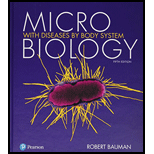
1.
To determine:
The test might the doctor run to diagnose the disease.
Case summary:
An old man who is 43 years old is suffering from HIV for 8 years. He is hospitalized due to mental confusion as well as disorientation, fever, headache, and a general discomfort. An enlarged liver is observed after further examination.
2.
To determine:
The opportunistic infection which is likely to be the cause of the man’s symptoms.
Case summary:
An old man who is 43 years old is suffering from HIV for 8 years. He is hospitalized due to mental confusion as well as disorientation, fever, headache, and a general discomfort. An enlarged liver is observed after further examination.
3.
To determine:
The patient’s maximum count, as the doctor performs a CD4+ cell count.
Case summary:
An old man who is 43 years old is suffering from HIV for 8 years. He is hospitalized due to mental confusion as well as disorientation, fever, headache, and a general discomfort. An enlarged liver is observed after further examination.
4.
To determine:
The way in which patient most likely become infected.
Case summary:
An old man who is 43 years old is suffering from HIV for 8 years. He is hospitalized due to mental confusion as well as disorientation, fever, headache, and a general discomfort. An enlarged liver is observed after further examination.
5.
To determine
The probable outcome for a non-immunological patient with the same
Case summary:
An old man who is 43 years old is suffering from HIV for 8 years. He is hospitalized due to mental confusion as well as disorientation, fever, headache, and a general discomfort. An enlarged liver is observed after further examination.
Want to see the full answer?
Check out a sample textbook solution
Chapter 21 Solutions
Microbiology with Diseases by Body System (5th Edition)
- For short answer questions, write your answers on the line provided. To the right is the mRNA codon table to use as needed throughout the exam. First letter U บบบ U CA UUCPhe UUA UCU Phe UCC UUG Leu CUU UAU. G U UAC TV UGCys UAA Stop UGA Stop A UAG Stop UGG Trp Ser UCA UCG CCU] 0 CUC CUA CCC CAC CAU His CGU CGC Leu Pro CCA CAA Gin CGA Arg CUG CCG CAG CGG AUU ACU AAU T AUC lle A 1 ACC Thr AUA ACA AUG Mot ACG AGG Arg GUU GCU GUC GCC G Val Ala GAC Asp GGU GGC GUA GUG GCA GCG GAA GGA Gly Glu GAGJ GGG AACASH AGU Ser AAA1 AAG Lys GAU AGA CAL CALUCAO CAO G Third letter 1. (+7) Use the table below to answer the questions; use the codon table above to assist you. The promoter sequence of DNA is on the LEFT. You do not need to fill in the entire table. Assume we are in the middle of a gene sequence (no need to find a start codon). DNA 1 DNA 2 mRNA tRNA Polypeptide C Val G C. T A C a. On which strand of DNA is the template strand (DNA 1 or 2)?_ b. On which side of the mRNA is the 5' end (left or…arrow_forward3. (6 pts) Fill in the boxes according to the directions on the right. Structure R-C R-COOH OH R-OH i R-CO-R' R R-PO4 R-CH3 C. 0 R' R-O-P-OH 1 OH H R-C-H R-N' I- H H R-NH₂ \H Name Propertiesarrow_forward4. (6 pts) Use the molecule below to answer these questions and identify the side chains and ends. Please use tidy boxes to indicate parts and write the letter labels within that box. a. How many monomer subunits are shown? b. Box a Polar but non-ionizable side chain and label P c. Box a Basic Polar side chain and label BP d. Box the carboxyl group at the end of the polypeptide and label with letter C (C-terminus) H H OHHO H H 0 HHO H-N-CC-N-C-C N-C-C-N-GC-OH I H-C-H CH2 CH2 CH2 H3C-C+H CH2 CH2 OH CH CH₂ C=O OH CH2 NH2arrow_forward
- please draw in what the steps are given. Thank you!arrow_forwardplease draw in and fill out the empty slots from image below. thank you!arrow_forwardThere is a species of eagle, which lives in a tropical forest in Brazil. The alula pattern of its wings is determined by a single autosomal gene with four alleles that exhibit an unknown hierarchy of dominance. Genetic testing shows that individuals 1-1, 11-4, 11-7, III-1, and III-4 are each homozygous. How many possible genotypes among checkered eagles in the population?arrow_forward
- Essentials of Pharmacology for Health ProfessionsNursingISBN:9781305441620Author:WOODROWPublisher:Cengage
 Medical Terminology for Health Professions, Spira...Health & NutritionISBN:9781305634350Author:Ann Ehrlich, Carol L. Schroeder, Laura Ehrlich, Katrina A. SchroederPublisher:Cengage LearningBasic Clinical Lab Competencies for Respiratory C...NursingISBN:9781285244662Author:WhitePublisher:Cengage
Medical Terminology for Health Professions, Spira...Health & NutritionISBN:9781305634350Author:Ann Ehrlich, Carol L. Schroeder, Laura Ehrlich, Katrina A. SchroederPublisher:Cengage LearningBasic Clinical Lab Competencies for Respiratory C...NursingISBN:9781285244662Author:WhitePublisher:Cengage





